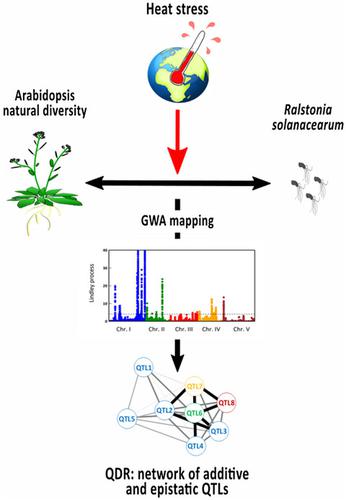当前位置:
X-MOL 学术
›
Mol. Plant Pathol.
›
论文详情
Our official English website, www.x-mol.net, welcomes your
feedback! (Note: you will need to create a separate account there.)
A complex network of additive and epistatic quantitative trait loci underlies natural variation of Arabidopsis thaliana quantitative disease resistance to Ralstonia solanacearum under heat stress.
Molecular Plant Pathology ( IF 4.8 ) Pub Date : 2020-09-11 , DOI: 10.1111/mpp.12964 Nathalie Aoun 1 , Henri Desaint 1, 2 , Léa Boyrie 3 , Maxime Bonhomme 3 , Laurent Deslandes 1 , Richard Berthomé 1 , Fabrice Roux 1
Molecular Plant Pathology ( IF 4.8 ) Pub Date : 2020-09-11 , DOI: 10.1111/mpp.12964 Nathalie Aoun 1 , Henri Desaint 1, 2 , Léa Boyrie 3 , Maxime Bonhomme 3 , Laurent Deslandes 1 , Richard Berthomé 1 , Fabrice Roux 1
Affiliation

|
Plant immunity is often negatively impacted by heat stress. However, the underlying molecular mechanisms remain poorly characterized. Based on a genome‐wide association mapping approach, this study aims to identify in Arabidopsis thaliana the genetic bases of robust resistance mechanisms to the devastating pathogen Ralstonia solanacearum under heat stress. A local mapping population was phenotyped against the R. solanacearum GMI1000 strain at 27 and 30 °C. To obtain a precise description of the genetic architecture underlying natural variation of quantitative disease resistance (QDR), we applied a genome‐wide local score analysis. Alongside an extensive genetic variation found in this local population at both temperatures, we observed a playful dynamics of quantitative trait loci along the infection stages. In addition, a complex genetic network of interacting loci could be detected at 30 °C. As a first step to investigate the underlying molecular mechanisms, the atypical meiotic cyclin SOLO DANCERS gene was validated by a reverse genetic approach as involved in QDR to R. solanacearum at 30 °C. In the context of climate change, the complex genetic architecture underlying QDR under heat stress in a local mapping population revealed candidate genes with diverse molecular functions.
中文翻译:

加性和上位性数量性状基因座的复杂网络是拟南芥定量疾病对热胁迫下番茄青枯菌抗性的自然变异的基础。
植物免疫力经常受到热胁迫的不利影响。但是,潜在的分子机制仍然不好表征。本研究基于全基因组关联作图方法,旨在鉴定拟南芥对热胁迫下对毁灭性青枯菌青枯菌的强大抗性机制的遗传基础。针对青枯菌表型的本地制图人群GMI1000应变在27和30°C下。为了获得对定量抗病性(QDR)自然变异的潜在遗传结构的精确描述,我们应用了全基因组局部评分分析。在这两个温度下,除了在该本地人群中发现广泛的遗传变异外,我们还观察到了感染阶段的数量性状基因座的动态变化。此外,可以在30°C下检测到一个复杂的相互作用基因座遗传网络。作为研究潜在分子机制的第一步,通过反向遗传方法验证了非典型减数分裂细胞周期蛋白SOLO DANCERS基因是否参与青枯菌的QDR研究。在30°C下。在气候变化的背景下,局部测图种群在热胁迫下QDR的复杂遗传结构揭示了具有多种分子功能的候选基因。
更新日期:2020-10-13
中文翻译:

加性和上位性数量性状基因座的复杂网络是拟南芥定量疾病对热胁迫下番茄青枯菌抗性的自然变异的基础。
植物免疫力经常受到热胁迫的不利影响。但是,潜在的分子机制仍然不好表征。本研究基于全基因组关联作图方法,旨在鉴定拟南芥对热胁迫下对毁灭性青枯菌青枯菌的强大抗性机制的遗传基础。针对青枯菌表型的本地制图人群GMI1000应变在27和30°C下。为了获得对定量抗病性(QDR)自然变异的潜在遗传结构的精确描述,我们应用了全基因组局部评分分析。在这两个温度下,除了在该本地人群中发现广泛的遗传变异外,我们还观察到了感染阶段的数量性状基因座的动态变化。此外,可以在30°C下检测到一个复杂的相互作用基因座遗传网络。作为研究潜在分子机制的第一步,通过反向遗传方法验证了非典型减数分裂细胞周期蛋白SOLO DANCERS基因是否参与青枯菌的QDR研究。在30°C下。在气候变化的背景下,局部测图种群在热胁迫下QDR的复杂遗传结构揭示了具有多种分子功能的候选基因。










































 京公网安备 11010802027423号
京公网安备 11010802027423号